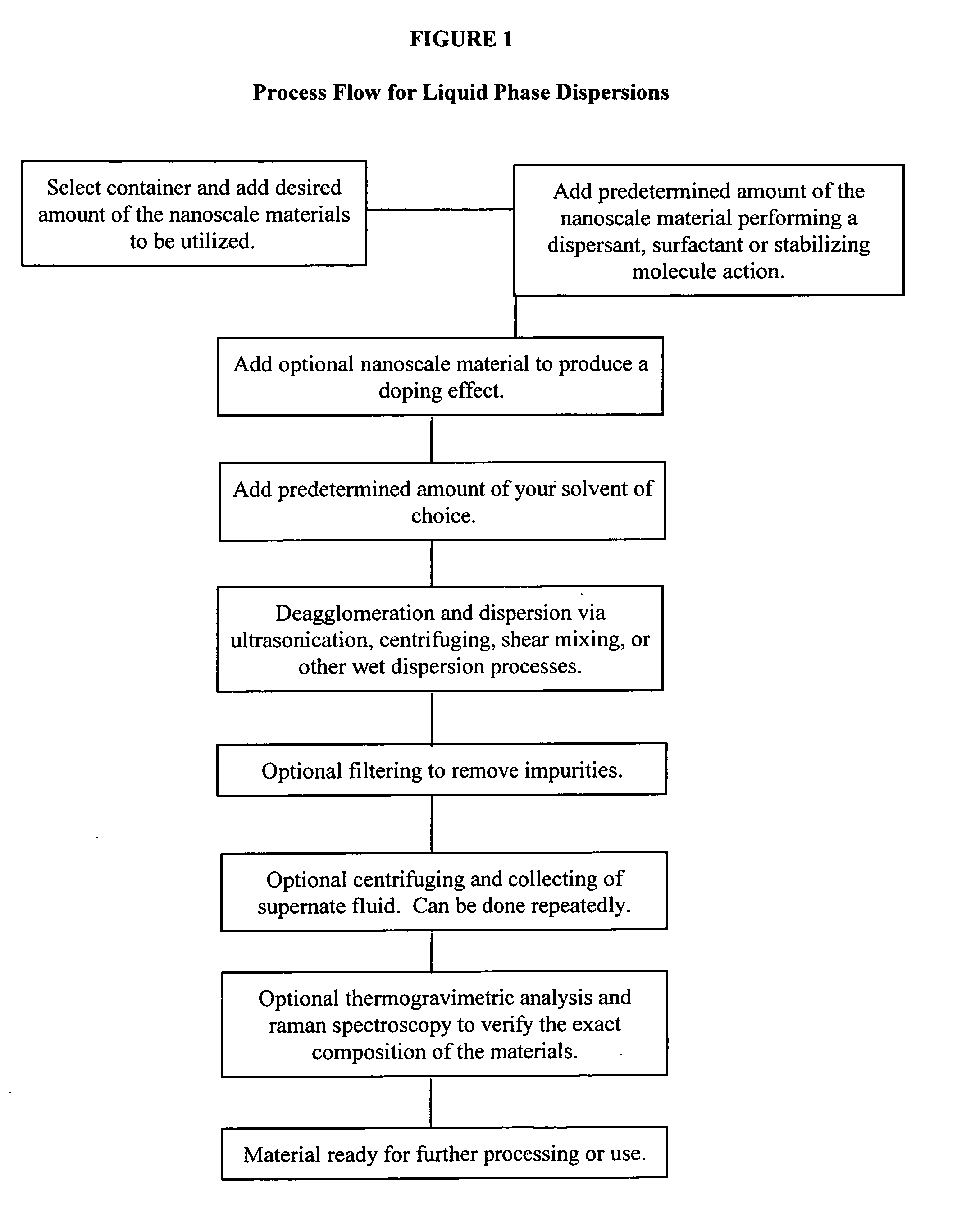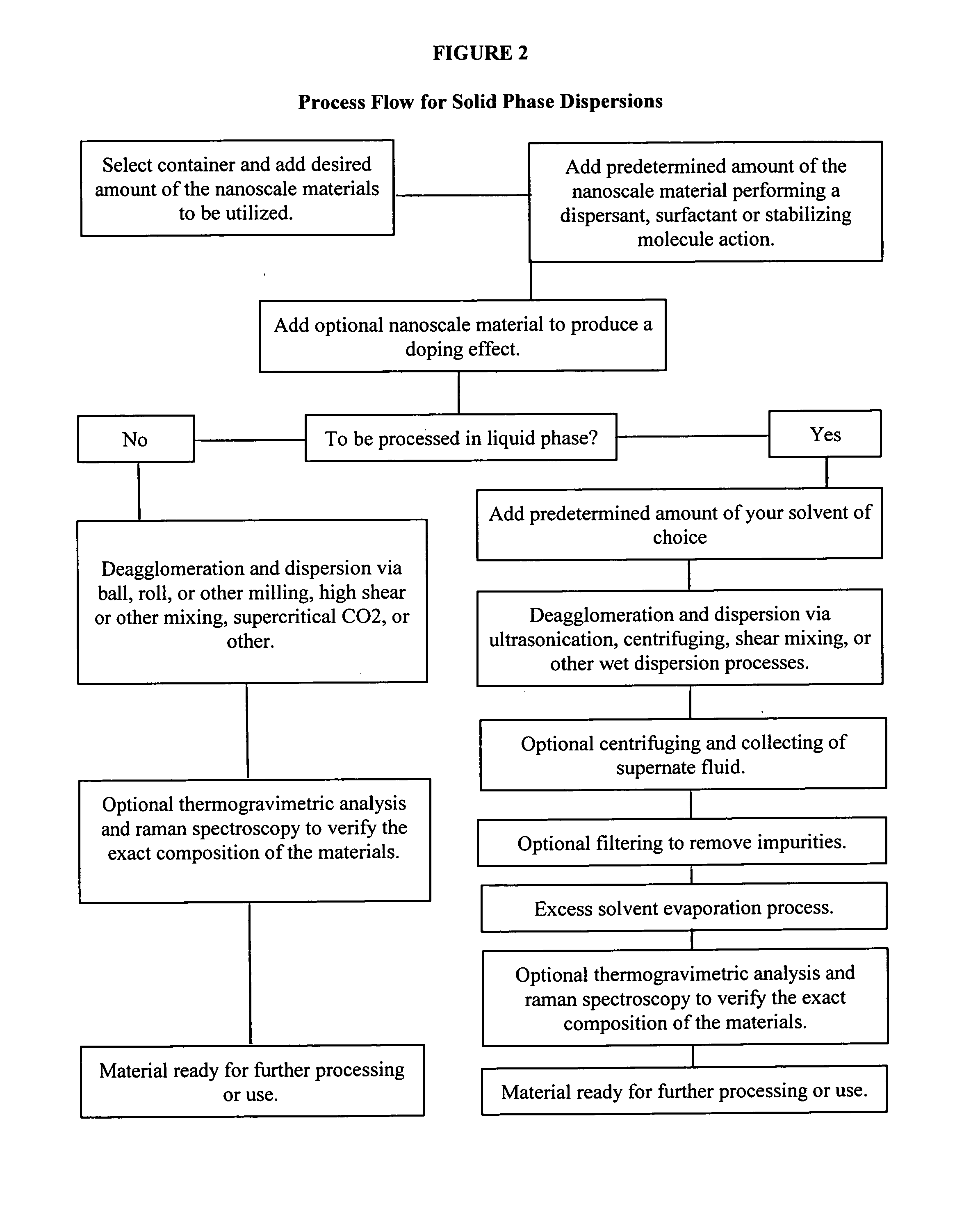Utilizing nanoscale materials as dispersants, surfactants or stabilizing molecules, methods of making the same, and products produced therefrom
a nano-scale material and nano-particle technology, applied in the field of nano-particle dispersions, can solve the problems of poor performance, interference with the end use of thin film or other products,
- Summary
- Abstract
- Description
- Claims
- Application Information
AI Technical Summary
Benefits of technology
Problems solved by technology
Method used
Image
Examples
example 1
[0085]In this embodiment, Single Layer Graphene Oxide (SLGO) is used to disperse Multi Walled Carbon Nanotubes (MWNTs) in N-Methylpyrrolidone (NMP). MWNTs (200 mgs) are combined with 25-50 mgs of silver nanowires and are dispersed into 250-500 mls NMP with SLGO being used as a surfactant in the range from 5-125 wt % of the MWNTs producing a solution that is stable for at least one week.
[0086]This solution can then be employed as a conductive ink which is typically comprised of a colloidal suspension of nanometer-sized metal and other particles coated with a thin stabilizer (surfactant) shell. The resulting ink can then be deposited by ink jet printing, screen printing, meyer rod, draw bar, other printing methods, spin coating, dip coating, drop casting, or other sol-gel methods. By practicing this invention, it is possible to achieve similar or higher conductivity using less of the silver nanowires or MWNTs thus gaining a significant cost savings. It is also possible to use other, m...
example 2
[0091]In this embodiment, Single Layer Graphene Oxide (SLGO) is used to disperse a conductive nanoscale material (100 mgs) such as SWNTs, DWNTs, TWNTs, or MWNTs, fullerenes, graphene, graphene nanoplatelets, or other conductive nano materials in 500 mls of Dimethylformamide (DMF), N-Methylpyrrolidone (NMP), Isopropanol (IPA), dichlorobenzene, or deionized water (DI Water) for transparent conductive coating applications. The conductive second nanomaterial is dispersed into 500 mls Di water with SLGO being used as a surfactant in the range from 50-500 wt % of the SWNTs. For transparent conductive coating applications, it is often desirable to use more of the material providing a dispersant, surfactant, or stabilizing action to keep the conductive nanomaterials well separated in the coating. The solvent being used will often dictate which material should be used for the second nanoscale materials providing a dispersant, surfactant, or stabilizing molecule action. For example, if workin...
example 3
[0098]In this embodiment, Graphene Nanoplatelets (GNPs) is used to disperse multi walled carbon nanotubes (MWNTs) in Isopropanol (IPA). The GNPs are soluble in IPA and the MWNTs are not. One gram of MWNTs was dispersed into 100 mls IPA with GNPs being used as a surfactant in the range from 5-125 wt % of the MWNTs. This dispersion can then be dehydrated by baking it at 225 C for 4 hours to completely remove the solvent and the resulting dry powder can be further processed in a solid state which is desirable for plastics and composite applications. Additionally, the dehydrated powder can now function as a hybrid material of MWNTs with a surfactant already added to them. This presents a novel method to add surfactants to carbon nanotubes prior to use in plastics, polymers, composite materials many other applications in which the additive materials must be in solid form.
PUM
| Property | Measurement | Unit |
|---|---|---|
| wt % | aaaaa | aaaaa |
| wt % | aaaaa | aaaaa |
| wt % | aaaaa | aaaaa |
Abstract
Description
Claims
Application Information
 Login to View More
Login to View More - R&D
- Intellectual Property
- Life Sciences
- Materials
- Tech Scout
- Unparalleled Data Quality
- Higher Quality Content
- 60% Fewer Hallucinations
Browse by: Latest US Patents, China's latest patents, Technical Efficacy Thesaurus, Application Domain, Technology Topic, Popular Technical Reports.
© 2025 PatSnap. All rights reserved.Legal|Privacy policy|Modern Slavery Act Transparency Statement|Sitemap|About US| Contact US: help@patsnap.com


